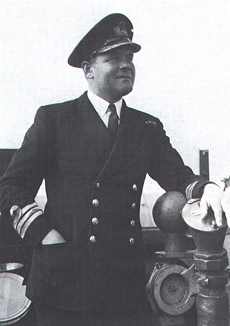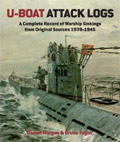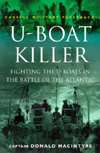Donald George Frederick Wyville MacIntyre DSO, DSC, RN
| Born | 26 Jan 1904 | Dehra Dun, Uttarakhand, India | |
| Died | 23 May 1981 | (77) | Ashford, Kent, England |
 Captain Donald Macintyre | Ranks
Retired: 7 Jul 1955 Decorations
|
Warship Commands listed for Donald George Frederick Wyville MacIntyre, RN
| Ship | Rank | Type | From | To |
| HMS Venomous (D 75) | Lt.Cdr. | Destroyer | 31 Jul 1939 | 8 Jan 1940 |
| HMS Hesperus (H 57) | Lt.Cdr. | Destroyer | Jan 1940 | Feb 1941 |
| HMS Walker (D 27) | Cdr. | Destroyer | Feb 1941 | Mar 1943 |
| HMS Hesperus (H 57) | Cdr. | Destroyer | July 1942 | 22 Mar 1944 |
| HMS Bickerton (K 466) | Cdr. | Frigate | Mar 1944 | 22 Aug 1944 |
Career information
Destroyer Captain and Escort Group Commander
The fate of three U-boats
During the summer of 1940 and on through the winter the Atlantic convoys had suffered terrible losses, and in addition filthy weather had plagued both escorts and merchantmen from the North Channel across the wide sweep up to Iceland.
In Germany, three bold and famous captains, Prien (U-47), Schepke (U-100) and most famous of all Kretschmer (U-99), were credited with the majority of these losses, and in early March 1941 all three were at sea together for the first time.
U-47 was lost to unknown causes early in March and the oft-mentioned attack by HMS Wolverine was in fact against the U-A which escaped unharmed.
Meanwhile Captain Donald MacIntyre in H.M.S. Walker and his newly formed 5th Escort Group had met convoy HX112, some fifty deeply laden merchantmen, and were steaming eastwards in calm, but bitterly cold weather.
Schepke attacked HX-112 at dusk on the 15th, approaching on the surface and firing a salvo of torpedoes at the long line of overlapping silhouettes. Despite an intense hunt by the escorts Schepke in U-100 escaped, and the next night joined in the torpedoing and sinking of five more ships in the convoy. While the convoy stayed in perfect formation, the escorts raced around trying to locate the almost invisible enemy.
Later, while engaged in picking up survivors from one of the torpedoed ships H.M.S. Vanoc (Commander Deneys) detected U-100 by radar (the first recorded detection of a surfaced submarine by the primitive radar sets then in existence). Commander Deneys immediately gave chase, and after some fast and brilliant ship-handling succeeded in ramming U-100, killing Schepke in his conning-tower, and leaving only 6 survivors to be picked up by Vanoc.
Circling Vanoc in protection while she examined herself for damage Walker detected another U-boat by ASDIC, and ran in fast to deliver a pattern of six depth-charges. As they exploded Walker turned to deliver another attack, but a searchlight beam from Vanoc illuminated U-99 on the surface astern of her. She lay stopped, and her crew abandoned her just before she plunged to the bottom, many fathoms down.
MacIntyre manoeuvred Walker to windward of the swimming Germans, and as she drifted down on to them, they were hauled on board. The last to come on board was clearly the U-boat captain, as he swam to "Walker" still wearing his brass-bound cap, and still having his large Zeiss binoculars, a very special pair made at Doenitz orders, slung round his neck. Kretschmer tried to throw them overboard, but a junior British officer grabbed them just in time, and in due course they arrived on Walker's bridge where MacIntyre claimed them as his prize of war.
Second World War:
After a spell of commanding H.M.S. Venomous, a destroyer veteran of the 1914-18 war, he was instructed to commission H.M.S. Hesperus, a destroyer very much like the British H-class, being built with five sisters for the Brazilian Navy and taken over by the Royal Navy. She was badly damaged by German dive-bombers off Norway, and after repairs assigned to escort duty in the Western Approaches.
On returning to Liverpool in March 1941 MacIntyre was ordered to take over H.M.S. Walker, an old and rather battered destroyer. With the command of Walker went the command of one of the newly-formed Escort Groups, the 5th, consisting, in addition to his own ship, of the destroyers Vanoc, Volunteer, Sardonyx and Scimitar (all of First World War vintage) and the corvettes Bluebell and Hydrangea. After hard and strenuous escort work (see 'The fate of three U-boats') the Escort Group was disbanded, and after a period in dock H.M.S. Walker, now equipped with radar, was based at Hvalfjord as part of a screening force for the Home Fleet battleships based there.
In February 1942, she was transferred to Halifax, Nova Scotia as part of the Western Local Escort Force. At that time, during Operation Paukenschlag, the practically un-escorted shipping suffered terrible, and in many cases totally unnecessary, losses along the entire American Eastern Seaboard.
In June 1942 Macintyre was appointed to command Escort Group B2, consisting of his old ship Hesperus, the destroyer H.M.S. Vanessa and the Flower-class corvettes Gentian, Clematis, Heather, Campanula, Mignonette and Sweetbriar. In December 1942 near Rockall, while escorting convoy HX-219 homeward bound from Argentia, Hesperus, in a night-attack, rammed and sank U-357 (Kellner).
In April 1943, at the climax of the Battle of the Atlantic, Hesperus, now equipped with the new 'Hedgehog', sank U-191 (Fischer) SE of Cape Farewell. The convoy Hesperus and her Escort Group were escorting, ONS-4, had earlier been joined by a few ships from Reykjavik, and due to very foul weather and a far northerly route, endured the very long Atlantic crossing of nearly 16 days.
In early May 1943 Escort Group B2 left Argentia escorting the slow westbound convoy S129. On the 11th, in broad daylight, two ships in the convoy, the British S.S. Antigone and the Norwegian S.S. Grado were torpedoed by U-402 (v. Forstner) and quickly went down. Macintyre detected U-223 (Wächter) by radar, and very badly damaged her by ramming, but despite her injuries U-223 managed to limp home to her base at St. Nazaire. On the 14th, U-186 (Hasemann), using her radio in the vicinity of the convoy, was detected by H/F direction finding, and racing out on the bearing "Hesperus" quickly located her by ASDIC, and, in a series of depth-charge attacks, destroyed her with all hands.
A new type of anti-submarine ship, the American built Captain class, were now, in ever increasing numbers, being commissioned in the Royal Navy. In March 1944 Macintyre was ordered to take command of one of these frigates, H.M.S. Bickerton, and form the 5th Escort Group, consisting of the 24-knotters Bickerton, Aylmer and Bligh, and the 18-knotters Kempthorne, Keats and Goodson. After training hard together the Group departed on its first operation on April the 21st.
In Mid-Atlantic, the Germans maintained one or more U-boats, for the sole purpose of transmitting regular weather reports, a most important duty. With his second division screening the carrier HMS Vindex (Captain Bayliss), Macintyre in Bickerton detected, and in a Creeping Attack invented by Captain "Johnnie" Walker, destroyed U-765 (Wendt), the U-boat on duty as a 'weather reporter'.
Operating in the English Channel the Group on 15th June lost the frigate H.M.S. Mourne, a newcomer to Macintyre's command, to an acoustic torpedo from U-767 (Dankleff). On the 27th Bickerton detected and destroyed U-269 (Uhl) by depth-charges and gunfire.
In August 1944 while screening an Air Striking Force steaming to the far North for an attack on the German battleship Tirpitz at Tromsø, the escort carrier H.M.S. Nabob and Macintyre's frigate Bickerton were both torpedoed by the same U-boat. Nabob was towed to safety, but Bickerton, after suffering more than forty men killed and many more wounded, was considered expendable, and was sunk near Bear Island by a torpedo from one of the escorting destroyers. The U-boat responsible for these torpedo hits, U-354 (Stahmer), was sunk a few days later by British escorts.
After a truly magnificent effort in fighting the deadly U-boat threat, Captain MacIntyre's seagoing career was now ended, and he served ashore for the rest of the war.
He had greatly appreciated that, when Captain "Johnnie" Walker was buried at sea in 1944, it was MacIntyre's faithful Hesperus, with five U-boats to her credit, that carried him on his last journey out from Liverpool, down the Mersey and past the Bar Lightship.
Captain MacIntyre retired from the Navy on 7 July 1955.
His early career.
Donald Macintyre joined the Royal Navy in the twenties, and, having qualified as a pilot n the Fleet Air Arm, flew fighter aircraft from the carriers H.M.S. "Hermes" on the China station and H.M.S. "Courageous" in Home waters. After a serious illness he was passed fully fit for sea service again, and obtained command of H.M.S. Kingfisher, a new type of anti-submarine ship where he first acquired his overriding interest in sub-marine hunting. The late spring of 1939 found him enjoying his foreign service leave after a two-year commission in command of the destroyer Defender on the China station.
After the war ended he wrote numerous books, among them:
"U-BOAT KILLER", Avon Publications, Inc. New York 1956.
"THE BATTLE OF THE ATLANTIC", William Clowes and Sons, Ltd. London 1961.
"THE NAVAL WAR AGAINST HITLER", B.T. Batsford, Ltd. London 1971.
Lieutenant-Commander(ret.) Royal Danish Navy
Events related to this officer
Destroyer HMS Hesperus (H 57)
27 Jan 1940
HMS Hesperus (Lt.Cdr. D.G.F.W. MacIntyre, RN) departed Portsmouth for Portland where she arrived around 1530A/27.
At Portland she was to commence a work-up period. (1)
Destroyer HMS Walker (D 27)
16 Mar 1941
HMS Walker (Cdr. D.G.F.W. MacIntyre, RN) picks up 38 survivors from the Canadian merchant J.B. White that was torpedoed and sunk in the North Atlantic in position 60°57'N, 12°27'W by German U-boat U-99.
17 Mar 1941
German U-boat U-99 was scuttled at 0343hrs on 17 March 1941 south-east of Iceland, in position 61°00'N, 11°48W', after being badly damaged by depth charges from the British destroyer HMS Walker (Cdr. D.G.F.W. MacIntyre, RN).
17 Mar 1941
German U-boat U-100 was sunk at 0318hrs on 17 March 1941 south-east of Iceland, in position 61°04'N, 11°30'W, after being rammed by the British destroyer HMS Vanoc (Lt.Cdr. J.G.W. Deneys, RN) and depth charges from this destroyer and HMS Walker (Cdr. D.G.F.W. MacIntyre, RN).
Destroyer HMS Hesperus (H 57)
26 Dec 1942 (position 57.10, -15.40)
German U-boat U-357 was sunk in the North Atlantic north-west of Ireland, in position 57°10'N, 15°40'W by the British destroyers HMS Hesperus (Cdr. D.G.F.W. MacIntyre, DSO, RN) and HMS Vanessa (Lt. C.E. Sheen, RN). U-357 was forced to the surface by depth charges and was rammed by HMS Hesperus.
23 Apr 1943 (position 56.45, -34.25)
German U-boat U-191 was sunk south-east of Cape Farewell, Greenland, in position 56°45'N, 34°25'W, by depth charges from the British destroyer HMS Hesperus (Cdr. D.G.F.W. MacIntyre, DSO and Bar, RN).
12 May 1943 (position 41.54, -31.49)
German U-boat U-186 was sunk north of the Azores, in position 41°54'N, 31°49'W, by depth charges from the British destroyer HMS Hesperus (Cdr. D.G.F.W. MacIntyre, DSO and Bar, RN).
Frigate HMS Bickerton (K 466)
25 Jun 1944 (position 50.01, -2.59)
German U-boat U-269 was sunk in the English Channel south-east of Torquay, in position 50°01'N, 02°59'W, by depth charges from the British frigate HMS Bickerton (Cdr. D.G.F.W. MacIntyre, DSO and 2 Bars, RN)
Media links
|
|
Sources
- ADM 53/113003 + ADM 199/2556
ADM numbers indicate documents at the British National Archives at Kew, London.
You can help improve officers Donald George Frederick Wyville MacIntyre's page
Click here to Submit events/comments/updates for this officer.
Please use this if you spot mistakes or want to improve his page.
As an Amazon Associate uboat.net earns a commission from qualifying purchases.



